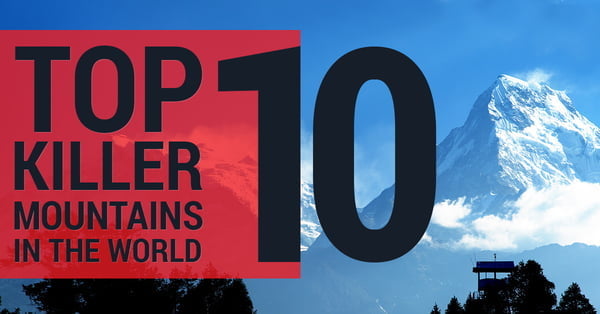
Mountaineering
BeginnerHiking
BeginnerRock Climbing
BeginnerIce Climbing
BeginnerBackcountry Skiing
BeginnerMountain Planet
12 years, Australia
TOP-10 KILLER MOUNTAINS IN THE WORLD

Tallest does not always mean toughest. There are plenty of mountains lower than Mount Everest and much more deadly.
Some of them merely sweep away climbers from its slopes. These peaks have earned the reputation of “white killers”, “man-eaters”, “savage rocks”, etc.
The typical threats expecting climbers on the world’s deadliest mountains are:
- unpredictable ice slides and avalanches hazards;
- lack of oxygen on high altitudes responsible for cerebral edema and severe pneumonia;
- wild winds and weather changes which can literally blow climbers away;
- extremely difficult to overcome climbing sections responsible for climbers falls;
- hugely low temperatures causing serious frostbites and hypothermia.
As mountaineering became more popular, overcrowding is making climbing mountains even more dangerous which is the case for Mont Blanc. Despite this fact destinations like Mont Blanc do not classify for our list. The accident rates of this mountain remains relatively low due to its large number of total climbs: nearly 30 000 annually.
These mountains command respect and fear from even the most experienced and daring climbers claiming lives of brave men and women daring to summit them.
Climbing is a highly risky activity even at beginning levels. But the risk is much smaller than mortal threats faced on world’s deadliest mountains. Climbers need to be 150% physically and most of all mentally prepared to face a mountain with some serious accidental records against them. There’s always a high possibility they won’t make it back.
In this story www.mountainplanet.com offers a glimpse at TOP-10 mountains which are responsible for the highest death rate amongst climbers*.
10. BROAD PEAK
First scaled in 1957
Location: China/ Pakistan
Parent Range: Karakorum
Elevation: 8 051 m / 26 414 ft
Death Rate: 5%
Broad Peak is the 12th tallest mountains in the world and is often mistakenly considered as one of the safest climbs among the 8 000 meters peaks. But the 5% accidental rate speaks for itself and positions Broad Peak on the 10th place in terms of death rankings.
9. SHISHAPANGMA
First scaled in 1964
Location: China
Parent Range: Himalaya
Elevation: 8 027 m / 26 335 ft
Death Rate: 8%
Mount Shishapangma was the last of the 8 000 meters high mountains to be scaled by humans. It is often labeled as a less challenging climb by the professional climbing community although since the first succesful attempt Mount Shishapangma took 29 lives including veteran climbers Bruno Carvalho from Portugal, Alex Lowe and Dave Bridges both from the US. The southwest face routes are more technically challenging offering climbers vertical gain of 2 200 meters on a 50-degree slope.
8. MAKALU
First scaled in 1955
Location: Nepal/ China
Parent Range: Himalaya
Elevation: 8 485 m / 27 838 ft
Death Rate: 9%
Makalu is the 5th world tallest mountain and one of the most difficult to summit. Makalu West Face is extremely technically demanding and considered one the most difficult routes in Himalayas which is yet to be tackled. Makalu peak is steep four sided pyramid which features constant hurricane winds with treacherous shifting ice.
7. GASHERBRUM 1
First scaled in 1958
Location: Pakistan/ China
Elevation: 8 080 m / 26 509 ft
Parent Range: Karakorum
Death Rate: 9%
Gasherbrum 1 is also nicknamed the Hidden Peak due to its extreme remoteness. It stands in the group of 5 peaks; together they form a semi-circle around South Gasherbrum glacier. Gasherbrum 1 is regarded a technically difficult climb with a few attempts ending successfully through 5 years time or more. Only the most experienced high-altitude climbers dare to think about of conquering this rare visited mountain.
6. MANASLU
First scaled in 1956
Location: Nepal
Elevation: 8 163 m / 26 782 ft
Parent Range: Himalaya
Death Rate: 10%
Manaslu shouldn't be underestimated. The peak is quite short for the Himalayan standards and it can be easily summited under ideal conditions by a team of professional athletes. But there’s hardly an avalanche safe zone from the base camp to the high camp on the classic route. Naturally released avalanches come unexpectedly severely injuring and killing сlimbers on its way.
5. KANGCHEJUNGA
First scaled in 1955
Location: India/ Nepal
Elevation: 8 586 m / 28 169 ft
Parent Range: Himalaya
Death Rate: 15%
Kangchenjunga literally means «The five treasures of Snows» in reference to 5 peaks forming a single Kangchenjunga Massif. But this mountain is also labeled as «consistently deadly». This fearsome peak exposes climbers to one of the most hostile environments on earth with wild winds, extremely low temperatures and predictably unpredictable avalanches. Most of the dangerous mountains decreased the accident rate with time, except Kangchenjunga, which seem to be getting more lethal over the time. Basically one out five climbers perishes while attempting to conquer this mountain.
4. DHAULAGIRI 1
First scaled in 1960
Location: Nepal
Elevation: 8 167 m / 26 795 ft
Parent Range: Himalaya
Death Rate: 16%
Dhaulagiri 1 is the 7th world tallest mountainand has a bad reputation for disappearing climbers on its slopes. The south face of Dhaulagiri 1 has been never climbed and generally considered a suicidal ascent. The greatest threat posed to climbers is avalanches, which buried many brave climbers who dared to challenge Dhaulagiri 1. Amongst the 8 000 meters peak Dhaulagiri 1 was the second last to be ascended.
3. NANGA PARBAT
First scaled in 1953
Location: Pakistan
Elevation: 8 125 m / 26 657 ft
Parent Range: Himalaya
Death Rate: 21%
Nanga Parbat is nicknamed «man-eater» in reference to variety of accidental threats it poses to climbers. This world ninth-highest mountain may rival K2 in terms of technical difficulty. Nanga Parbat is an extremely treacherous climb that requires 200% concentration and respect for every inch of the climb. Its famous Rupal Face rises nearly 4 600 meters, making it the largest “big wall” on the planet which demands excellent technical skills and pushes climbers to the edge of human physical limits to overpass it.
31 attempts on Nanga Parbat ended in death before the successful route was found in 1953.
Nanga Parbat and K2 were the only two that had yet to be climbed in winter. On February 26, 2016 that list narrowed to one. Simone Moro, of Italy, Alex Txikon, of Spain, and Ali Sadpara, of Pakistan, reached the summit of Nanga Parbat via the Kinshofer Route, claiming the mountain’s coveted first winter ascent.
2. K2
First scaled in 1952
Location: Pakistan/ China
Elevation: 8 611 m / 28 251 ft
Parent Range: Karakorum
Death Rate: 29%
One from four climbers attempting to climb the K2 dies. This mountain is the second tallest mountain in the world but it offers a far more difficult climb than Mount Everest or any other out of the previous eight thousanders. Some say K2 materializes every fear a climber can possibly think of: wild weather, hurricane winds, minus 50С temperatures, ice shifting, avalanches, rock steep sections, crevasses, etc, etc. The bottle neck portion of the сlimb is regarded as most treacherous.
K2 was never climbed in winter. For its dreadfully unforgiving reputation K2 was labeled «Savage Mountain».
1. ANNAPURNA 1
First scaled in 1950
Location: Nepal
Elevation: 8 091 m / 26 545 ft
Parent Range: Himalaya
Death Rate: 34%
Annapurna 1 kills one third of people who dare to summit it which makes it the most deadly mountain of the world. One of the last tragedies occurred in October 2015 when 39 souls perished on the slopes of Annapurna 1 after series of deadly avalanches. The technical difficulty of the climb in combination with frequent and sudden avalanches is giving Annapurna 1 over 30% accident rate.
The south face of the mountain is considered one of the most dangerous climb in the world. What’s interesting though is the fact that Annapurna, the deadliest mountain in majority of the rankings, was the first among 8 000 meters peak to be climbed.
Annapurna 1 has taken away some of the most recognized and skilled veteran climbers including the Russian Kazakh Anatoli Bourkeev, the Spaniard Inaki Ochoa and the French man Pierre Beghin.
Mountains should be never underestimated. When scaling even most crowded mountains like Mont Blanc one should not be lured by its relatively easy access or number of people who have successfully summited it. One of the reasons Mont Blanc has taken over 2 000 lives in modern times (nearly 8 000 in total since first ascent in 18 century) is that it’s often promoted as a long hike rather than a technical climb.
For this reason it is highly recommended to use mountain guides services even at the widely popular climbing destinations.
Mountainplanet.com features descriptions on tons of routes mountains as well as feedback from fellow climbers and professional mountain guides on the most challenging mountaineering destinations. Join Mountain Planet in our attempt to make mountains safer and more accessible for people by sharing secured and verified information on routes conditions and upcoming expeditions.
* All information and statistics for this story was gathered from open sources with assistance and consultation of professional mountain guides registered on www.mountainplanet.com.





